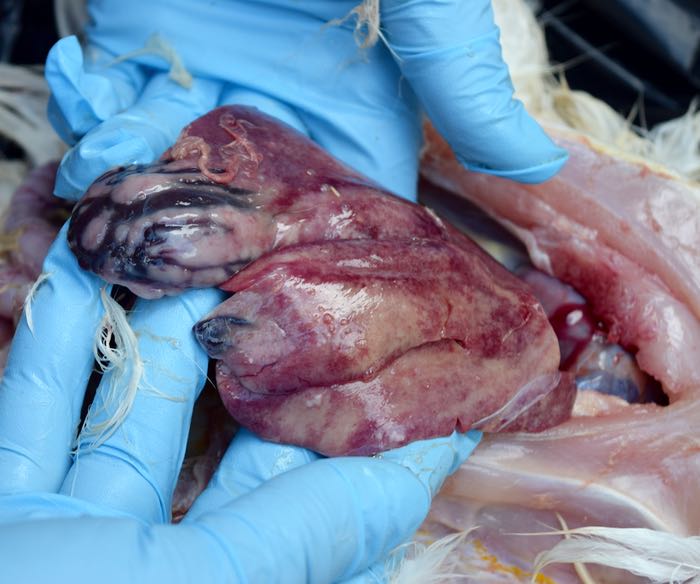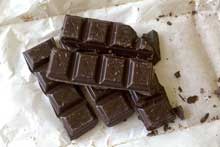Warning – graphic photo. (I put these up because my readers have told me they’re valuable. I’m sorry that they are difficult to look at.)
It was clear that Opal wasn’t going to recover, and that her time was up. Opal was a Delaware, an old-fashioned meat breed,which is a heavy placid hen, so, when I could see her keel bone projecting from a concave chest, I knew that despite the fact that she was still eating, that she was starving. Whatever was wrong was keeping her from processing her food.
Here is Opal as a three-year old.
I didn’t want her to suffer. Steve euthanized her. (He did a quick break of the neck.) Then I did the necropsy. I’d expected to find all sorts of things wrong with her reproductive tract. This is a hen that has had Infectious bronchitis, which causes eggs to be wrinkled and weak. I’d expected to see internal laying, or infection. Or tumors. I didn’t. Opal’s ovary was intact, but not functioning – no yolks were forming. What I did see was that her reproductive tract had broken, and that some of it had formed a ball of “lash.” (This is a white mass made up of the tract and sometimes bits of egg.) But, that’s not what she died of. She died of a severely diseased liver.
In the photo you can see how elongated and mottled it is, with dark splotches of hemorrhaging. I don’t have a lab and I’m not a veterinarian. So, I can tell you that this organ was obviously compromised, but not why. I’ve sent the photo off to a vet to look at. If you know what is going on here, please let me know. No wonder the poor bird was becoming emaciated. This is not a functioning organ. This is why I don’t encourage people to baby their sick hens by feeding gruel, etc. If your hen isn’t thriving, then it’s likely that the underlying cause is something so serious that keeping the hen alive by such measures only prolongs suffering. In an effort to keep content on the HenCam current, I often rework my FAQs. With Opal in mind, I have just rewritten the My Chicken Looks Sick! Now What? post. Do share.
The rest of Opal was healthy except… this is only the second hen that I’ve found roundworms in, and they were numerous. The other hen was also an older hen that had gone through a slow decline. I’m convinced that it’s the stressed hens that have issues with internal parasites. I’ve looked carefully at the manure in the barn. I don’t think that my healthy hens are infected, but I’ll be especially careful about removing manure to keep the parasite load low in the barn.
The flock of Gems is now down to nine. Opal’s leaving did not cause even a ripple in the social order. Everyone looks healthy, and despite the heat and humidity they’re laying (the ones that aren’t broody!) Hopefully there won’t be anymore serious issues this summer. But, they’re older chickens. You never know. I’m fine with that.



Fascinating. Sad, but fascinating. Thanks, Terry.
So sorry. In her prime Opal was a gorgeous “classic” hen.
So sorry about Opal. That is a yucky looking liver. Poor thing was probably in a lot of pain. Soooo glad you’re not one for long, last desperate measures. And thanks so much for the pictures. They are valuable indeed. Knowledge is so much better than ignorance and rose colored glasses.
Sad but very informative, not sure if I could do one. Sorry to ask but how do you dispose of their bodies ?
This also makes feel better about my decision with Sparkle. She too after her decline was the only one of my girls to pass some round worms. I wasted my efforts while trying to get her well, worming her (and in fact the entire flock) before she really went downhill. I now think I should have made the decision a little sooner but feel armed with more knowledge from you for the future. Thank you for all you do for your girls and in turn for all of us.
That’s why I write about these things. Sorry about Sparkle.
As always good info.
I too have learned that a sick hen is just not going to recover 99% of the time and I am much quicker to euthanize.
I appreciate you confirming what I’ve also observed. You and I both get upset when we see various on-line sites recommending all sorts “remedies” for sick hens, when we know that those things will only prolong suffering.
Very sorry about Opal!! I think the info/photos you show are very helpful!! I have learned a lot from it!!
Thank you for this informative post. It can’t be an easy thing to do and I really appreciate that it’s a very generous way to share advice and information with other chicken keepers.
Poor Opal. Rest in peace, girl. Amazing that her decline was caused by something you hadn’t considered. Her liver looks awful. I am not looking forward to the first time I need to euthanize but I appreciate your candor and information on the subject. And give my regards to Steve for taking on the responsibility and care needed for the act. Both of you show such care for your animals throughout their lives. Thank you for sharing the journey.
Rest in peace Opal. Yes these are graphic photos but I for one am glad of the info that you share with us, your readers. Sorry for your loss.
RIP Opal—and warm thoughts to you, Terry.
Curious about the photo: is that whole thing the liver? Is a liver normally that segmented? I gather the black areas are the hemorrhages. I did a completely amateur, seat-of-the-pants necropsy (with an x-acto knife) on a hen of mine that died two or three years ago. I found what I thought was her liver, but it looked nothing like this. It was yellow and fatty, and I assumed she had died of fatty liver disease. I was probably way off base…..Can you recommend a simple layperson-friendly book that clearly shows what a hen should look like inside (and maybe even how to do the necropsy correctly)? And is there a video you’d recommend that shows Steve’s euthanasia method?
The liver should be two smooth, firm reddish-brown lobes. There are no such books that are useful for the backyard chicken keeper. I learned to do a necropsy at a workshop – and we only used young and healthy cockerels. I’ve watched hours of video from Cornell about necropsy – none of which is about what happens in older hens. Even fatty liver disease looks different in young stock from industrial farms.
Steve learned the euthanasia method from a book. We’ve been meaning to make a video. I wish there was one out there to recommend so we wouldn’t have to do it.
Good information. Poor Opal. Once again you made the right decision.
A euthanasia video would be so sad to make, but helpful. I know Steve breaks the neck, and I think that’s the method I will eventually use (if I do it right it should be quick and painless?), but I want to get it right the First time! Meanwhile, perhaps you could name the reference book he used?
I’ll be looking into the videos from Cornell as I have yet to find any necropsy classes/workshops in my area. Thanks for that information as well.
Sorry for your loss Terry. Thank you for sharing this information.
P.S. Comment on you and Tonka-love the photo of “playing” with the huge soccer ball!
Thanks for posting that. I’ve been expecting it as I saw you had removed Opal’s photo from the Gems list and knew that she was no longer part of your life.
thank you for posting information & photo – I learn so much from your site. My Delaware, only 2 years old this spring, got sick about a week before Opal. She’d been a good layer, then stopped with fall moult and winter. After a few normal eggs this spring, she began passing egg liquid separately from egg shell. Then eggs stopped altogether and I assume she was laying internally. She was still perky and friendly until the final few days when she began getting off balance and then partially paralyzed – probably infection had set in. We euthanized her, she was still alert but couldn’t walk to food/water and heat wave was forecast.
You did the right thing. Hens never recover from the symptoms that you describe.
Thank you Terry
I am sorry for your loss! Not to be a doomsayer, but could it be lymphoma? I know that chicken hobbyists are very concerned about Marek’s disease here in MA.
As for necropsies- I consider myself un-squeamish. I kill and gut fish, I don’t look away when I have blood drawn, etc. But last spring my animal science class held a necropsy of a new-born lamb (to find out if it was still-born or if it had been crushed by its dam). It was a hot, humid sort of day, and the combination of the heat and smells and the sight of dark blood welling up from the flesh where the scalpel cut- I had to excuse myself and sit down for a while. Then I left for the day. I felt pretty embarassed about it for the rest of the semester. :^)
Odors can really set you back. Most chicken necropsies aren’t bad, but the one I did that had putrid fluid in the abdomen was done very quickly, indeed.
If she had roundworms, everyone is likely to have them. I understand that her system was weakened and worms thrive in weakened hens, but looking at everyone’s stool isn’t good enough until severe intestinal damage is already done. When they pass the worms, that means that their intestines were SO full of worms that the worms had no where else to go but out. If you saw some in her intestines, I’d highly recommend worming all of your girls. Even if you don’t believe me, it’d still be a good idea as a precautionary measure and won’t harm them. It’s better safe than sorry.
I wouldn’t worm without doing a fecal test to confirm if there are worms and what they are. Not all wormers act on all worms. Also, consistently worming with the same chemical creates resistance in the worms. I only like to use it as necessary. I do run fecal tests, and I’ll be doing one sooner rather than later because of what I saw in Opal.